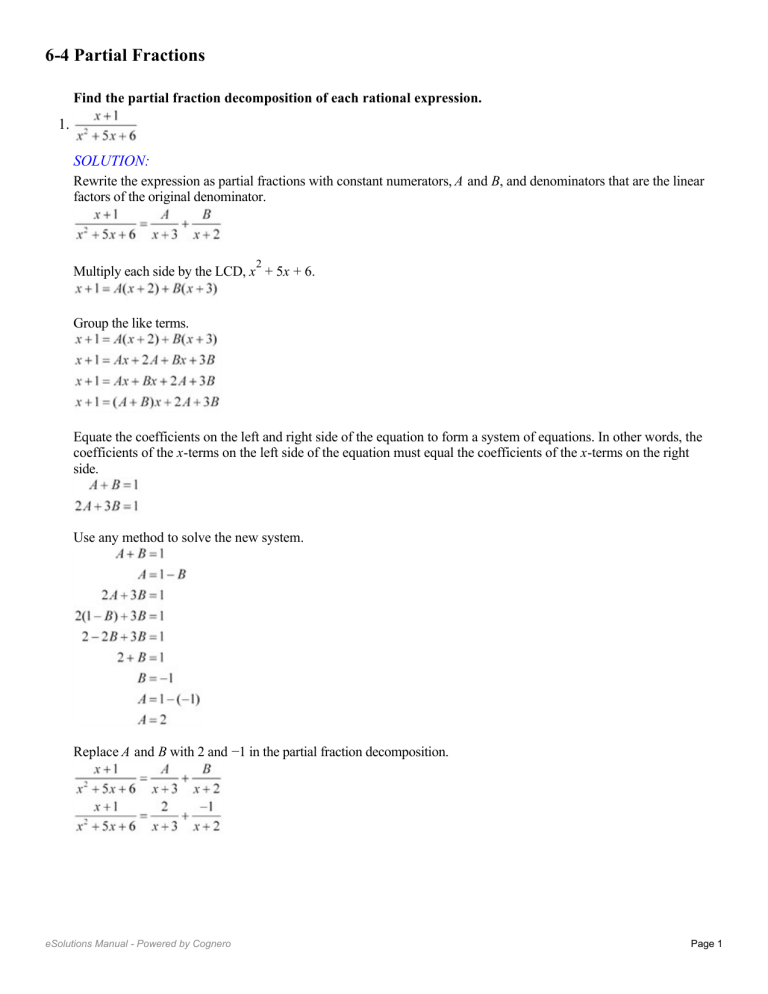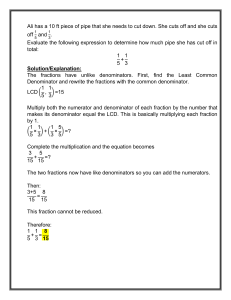
6-4 Partial Fractions Find the partial fraction decomposition of each rational expression. 1. SOLUTION: Rewrite the expression as partial fractions with constant numerators, A and B, and denominators that are the linear factors of the original denominator. 2 Multiply each side by the LCD, x + 5x + 6. Group the like terms. Equate the coefficients on the left and right side of the equation to form a system of equations. In other words, the coefficients of the x-terms on the left side of the equation must equal the coefficients of the x-terms on the right side. Use any method to solve the new system. Replace A and B with 2 and −1 in the partial fraction decomposition. 3. SOLUTION: Rewrite the expression as partial fractions with constant numerators, A and B, and denominators that are the linear Page 1 factors of the original denominator. eSolutions Manual - Powered by Cognero 6-4 Partial Fractions 3. SOLUTION: Rewrite the expression as partial fractions with constant numerators, A and B, and denominators that are the linear factors of the original denominator. 2 Multiply each side by the LCD, x + 7x + 12. Group the like terms. Equate the coefficients on the left and right side of the equation to form a system of equations. In other words, the coefficients of the x-terms on the left side of the equation must equal the coefficients of the x-terms on the right side. Use any method to solve the new system. Replace A and B with 10 and −9 in the partial fraction decomposition. 5. SOLUTION: Rewrite the expression as partial fractions with constant numerators, A and B, and denominators that are the linear factors of the original denominator. eSolutions Manual - Powered by Cognero Page 2 6-4 Partial Fractions 5. SOLUTION: Rewrite the expression as partial fractions with constant numerators, A and B, and denominators that are the linear factors of the original denominator. Multiply each side by the LCD, 2x 2 19x 45. Group the like terms. Equate the coefficients on the left and right side of the equation to form a system of equations. In other words, the coefficients of the x-terms on the left side of the equation must equal the coefficients of the x-terms on the right side. Use any method to solve the new system. Replace A and B with 3 and 1 in the partial fraction decomposition. Find the partial fraction decomposition of each improper rational expression. 7. SOLUTION: Because the degree of the numerator is greater than or equal to the degree of the denominator, the rational expression improper. To rewrite the expression, divide the numerator by the denominator. eSolutions Manual - is Powered by Cognero Page 3 Find the partial fraction decomposition of each improper rational expression. 7. 6-4 SOLUTION: Partial Fractions Because the degree of the numerator is greater than or equal to the degree of the denominator, the rational expression is improper. To rewrite the expression, divide the numerator by the denominator. Therefore, the proper rational expression is . Now we can rewrite the remaining expression as partial fractions with constant numerators, A, and B, and denominators that are the linear factors of the original denominator. 2 Multiply each side by the LCD, x − 2x. Group like terms. Equate the coefficients on the left and right side of the equation to form a system of equations. In other words, the coefficients of the x-terms on the left side of the equation must equal the coefficients of the x-terms on the right side. Use any method to solve the new system. Replace A, and B with 2, and 5 in the partial fraction decomposition. The partial fraction decomposition of the improper rational expression is 3 + . 9. eSolutions Manual - Powered by Cognero SOLUTION: Because the degree of the numerator is greater than or equal to the degree of the denominator, the rational Page 4 partialFractions fraction decomposition of the improper rational expression is 3 + 6-4 The Partial . 9. SOLUTION: Because the degree of the numerator is greater than or equal to the degree of the denominator, the rational expression is improper. To rewrite the expression, divide the numerator by the denominator. Therefore, the proper rational expression is . Now we can rewrite the remaining expression as partial fractions with constant numerators, A, B, and C, and denominators that are the linear factors of the original denominator. 3 2 Multiply each side by the LCD, x + 2x − 8x. Group like terms. Equate the coefficients on the left and right side of the equation to form a system of equations. In other words, the coefficients of the x-terms on the left side of the equation must equal the coefficients of the x-terms on the right side. Use any method to solve the new system. We now have a system of two equations and two variables. eSolutions Manual - Powered by Cognero Page 5 6-4 Partial Fractions We now have a system of two equations and two variables. Replace A, B, and C with 4, 1, and 3 in the partial fraction decomposition. The partial fraction decomposition of the improper rational expression is . 11. SOLUTION: Because the degree of the numerator is greater than or equal to the degree of the denominator, the rational expression is improper. To rewrite the expression, divide the numerator by the denominator. Therefore, the proper rational expression is . Now we can rewrite the remaining expression as partial fractions with constant numerators, A, and B, and denominators that are the linear factors of the original denominator. 2 Multiply each side by the LCD, x + 8x + 15. Group like terms. eSolutions Manual - Powered by Cognero Page 6 2 Multiply each side by the LCD, x + 8x + 15. 6-4 Partial Fractions Group like terms. Equate the coefficients on the left and right side of the equation to form a system of equations. In other words, the coefficients of the x-terms on the left side of the equation must equal the coefficients of the x-terms on the right side. Use any method to solve the new system. Replace A, and B with −8 and −6 in the partial fraction decomposition. The partial fraction decomposition of the improper rational expression is . Find the partial fraction decomposition of each rational expression with repeated factors in the denominator. 13. SOLUTION: The expression is proper, so we can rewrite the expression as partial fractions with constant numerators, A, B, and C, and denominators that are the linear factors of the original denominator. This time, however, we have repeated factors in the denominator. 3 2 x + 2x + x = x(x + 1)(x + 1) 2 Because the factor x + 1 has a multiplicity of 2, include partial fractions with denominators of x, x + 1, and (x + 1) . 2 Multiply each side by the LCD, x(x + 1) . eSolutions Manual - Powered by Cognero Page 7 The partial fraction decomposition of the improper rational expression is . 6-4 Partial Fractions Find the partial fraction decomposition of each rational expression with repeated factors in the denominator. 13. SOLUTION: The expression is proper, so we can rewrite the expression as partial fractions with constant numerators, A, B, and C, and denominators that are the linear factors of the original denominator. This time, however, we have repeated factors in the denominator. 3 2 x + 2x + x = x(x + 1)(x + 1) 2 Because the factor x + 1 has a multiplicity of 2, include partial fractions with denominators of x, x + 1, and (x + 1) . 2 Multiply each side by the LCD, x(x + 1) . Group like terms. Equate the coefficients on the left and right side of the equation to form a system of equations. In other words, the coefficients of the x-terms on the left side of the equation must equal the coefficients of the x-terms on the right side. Use any method to solve the new system. Replace A, B, and C with −3, 4, and 2 in the partial fraction decomposition. eSolutions Manual - Powered by Cognero 15. Page 8 6-4 Partial Fractions 15. SOLUTION: The expression is proper, so we can rewrite the expression as partial fractions with constant numerators, A, B, and C, and denominators that are the linear factors of the original denominator. This time, however, we have repeated factors in the denominator. 3 2 x + 10x + 25x = x(x + 5)(x + 5) 2 Because the factor x + 5 has a multiplicity of 2, include partial fractions with denominators of x, x + 5, and (x + 5) . 2 Multiply each side by the LCD, x(x + 5) . Group like terms. Equate the coefficients on the left and right side of the equation to form two equations with 2 variables. In other words, the coefficients of the x-terms on the left side of the equation must equal the coefficients of the x-terms on the right side. Use any method to solve the new system. Replace A, B, and C with −2, 1, and −7 in the partial fraction decomposition. eSolutions Manual - Powered by Cognero Page 9 6-4 Partial Fractions Replace A, B, and C with −2, 1, and −7 in the partial fraction decomposition. 17. SOLUTION: The expression is proper, so we can rewrite the expression as partial fractions with constant numerators, A, B, and C, and denominators that are the linear factors of the original denominator. This time, however, we have repeated factors in the denominator. 3 2 x − 16x + 64x = x(x − 8)(x − 8) 2 Because the factor x − 8 has a multiplicity of 2, include partial fractions with denominators of x, x − 8, and (x − 8) . 2 Multiply each side by the LCD, x(x − 8) . Group like terms. Equate the coefficients on the left and right side of the equation to form a system of equations. In other words, the coefficients of the x-terms on the left side of the equation must equal the coefficients of the x-terms on the right side. Use any method to solve the new system. eSolutions Manual - Powered by Cognero Replace A, B, and C with 4, −4, and 49 in the partial fraction decomposition. Page 10 6-4 Partial Fractions Use any method to solve the new system. Replace A, B, and C with 4, −4, and 49 in the partial fraction decomposition. 19. ENGINEERING The sum of the average tensile and shear stresses in the bar shown below can be approximated by , where x is the diameter of the pin. Art Change a. Find the partial fraction decomposition. b. Graph s(x) and the answer to part a in the same viewing window. SOLUTION: a. Decompose . First, divide the numerator by π. The fraction is proper, so we can rewrite the expression as partial fractions with constant numerators, A, B, and C, and denominators that are the linear factors of the original denominator. This time, however, we have repeated factors in the denominator. 3 2 2 x + x = (x )(x + 1) 2 2 Because the factor x has a multiplicity of 2, include partial fractions with denominators of x, x , and x + 1. eSolutions Manual - Powered by Cognero Multiply each side by the LCD, x 3 + x 2. Page 11

